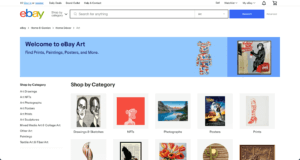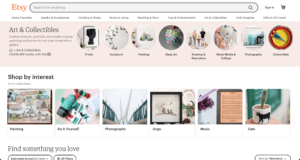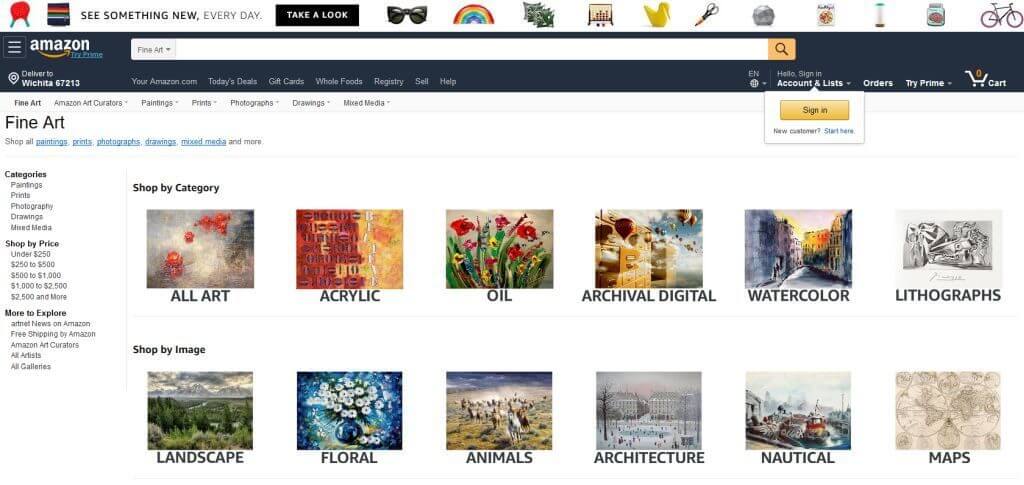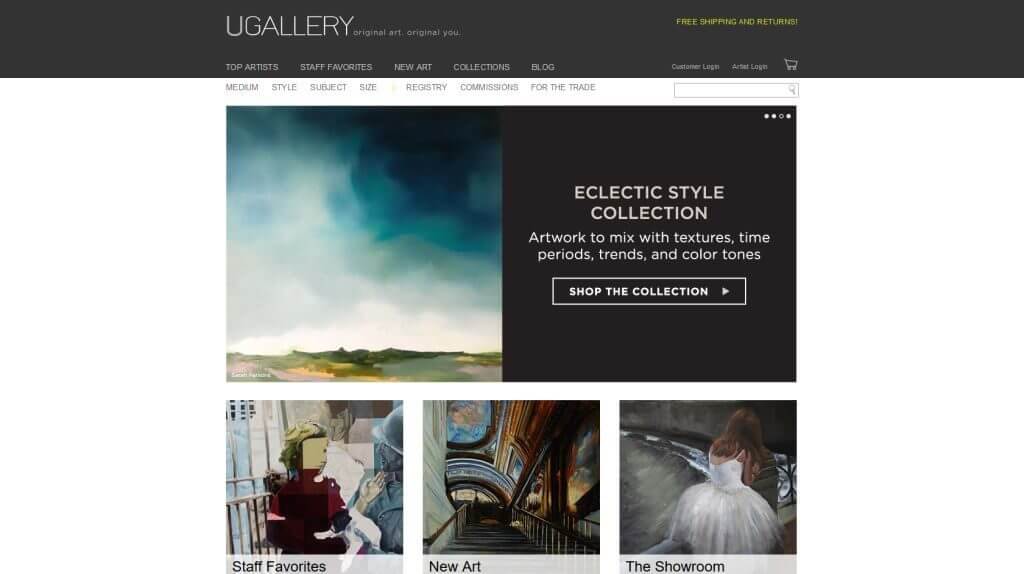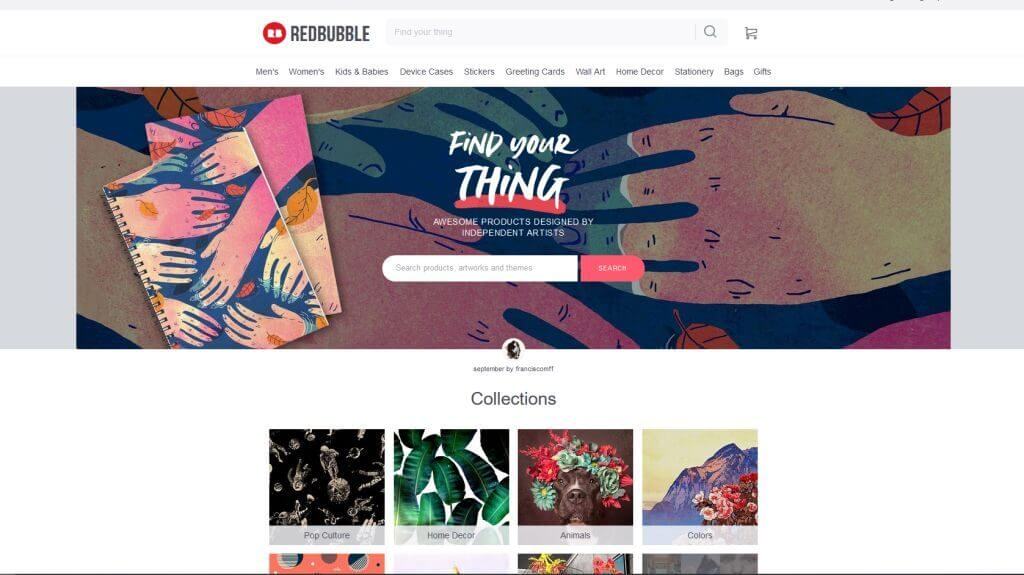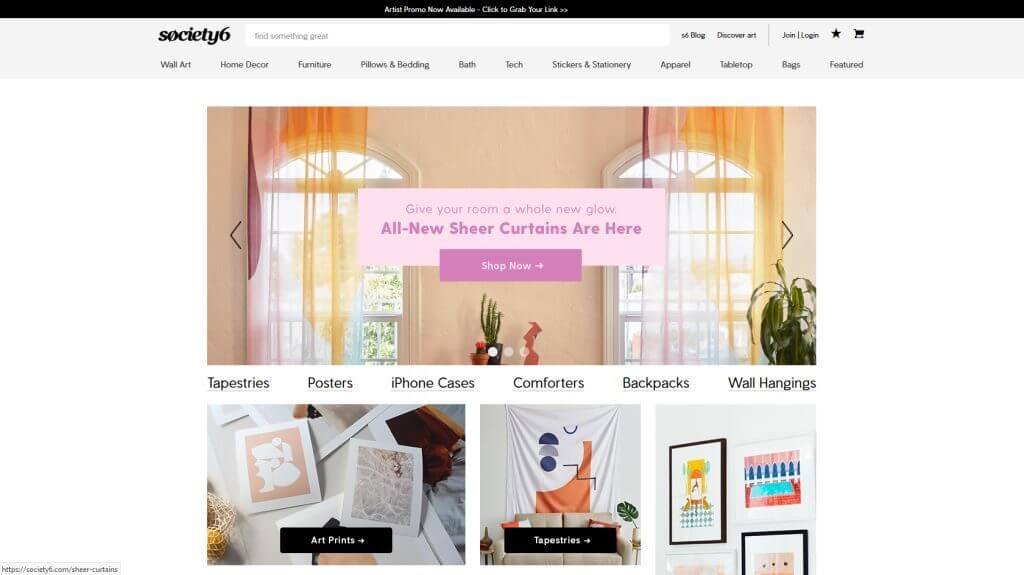As fun as it is to create art, most artists (myself included) can’t deny the thrill that comes from selling your art to someone who loves it. . . especially if you want your art to be a career, not just a hobby.
So today I’m going to share 12 of the easiest ways to start selling your art—and for those of you just starting out, I’ll end with 5 bonus tips to help you not only start selling but turn your occasional art sales into a viable, long-term business.

How to start selling your art
All of my recommendations fall into two categories: selling art online or offline.
For my online recommendations, I’m focusing on the “best, biggest, and simplest” options for artists. Yes, there are hundreds of smaller sites and services helping artists sell online. If you’re a member of a group or association like that, and it’s working for you, great! Keep on using it.
For many artists new to the world of art sales, however, those smaller sites are not going to be the best places to begin selling. Choosing a larger, more established online venue makes the setup process much quicker and easier—and you’ll reach more buyers as well.
And don’t forget about selling art offline, too! I’m including a ton of offline options because (believe it or not) you’ll probably find it easier to sell locally and in person than online. I’ll explain why further down. :)
Ready? Let’s get started!
1. Auction websites
Online auctions can be great places to get started selling art. Most of them are fairly easy to use (I’m recommending two of the best) and allow you to create an account for free. Just watch out for the listing fees, transaction fees, final value fees, and more.
The fees are usually small—often 3% or less—but they do add up. Don’t be surprised if you barely break even on the first few sales. That’s what happened to me until I had enough data to more accurately calculate all the fees and adjust my prices as needed.
If you want to sell art by auction, I’d recommend eBay or Webstore.com.
eBay is the online auction website most people think of when they think of selling online. It’s been around longer than most other online auctions and boasts the widest variety of auction categories. Many other online auctions cater to specific categories (Ubid focuses on overstocks, closeouts, and other items, for example) so eBay may be your best bet for selling art.
It’s also very easy to use once you become familiar with the interface. Getting started is simple: just open a free account, take (or scan) pictures, and start listing.
As I write this article, you can list 50 items a month with no upfront charge. You pay nothing unless an item sells. If you do sell something, you’ll be charged a listing fee and possibly a selling fee, so take those into account. You can also do fixed price sales (Buy It Now) on eBay.
Webstore.com is supported by donations and advertising. Every page has an ad at the top, and that can be annoying, BUT because of those ads there are 0% listing fees, 0% final value fees, and no commissions.
Like eBay, it’s easy to set up an account. There’s just one page of information to fill out, and you don’t have to include any of your financial information.
Many of the same types of artwork available on eBay are available here. Originals, reproductions, and art-related merchandise if you have it (mugs, t-shirts, etc.)
2. Online marketplaces
Unlike auction sites, if you list your artwork for sale at an online marketplace, there is no bidding. Items also often are listed for longer periods of time. Auction items are live for a week or ten days, but your listings on other sites may remain live for weeks or months, or until the item sells.
My top picks for this category are Etsy and Amazon Art.
Etsy is probably the most familiar name in online marketplaces. It began as a place to sell handmade items, and those types of items still make up a large portion of the sales. But it also expanded to include art and craft supplies, and vintage items whether they’re handmade or not.
If you already have a Google or Facebook account, you can use your Google or Facebook login to allow Etsy to “mine” your information and fill in your Etsy account. It’s still easy and fast to open an Etsy account without Google or Facebook, but that option makes it blindingly fast.
Etsy works for selling reproductions and original art, and even custom creations. A quick review of the available listings when I was doing research revealed a lot more abstract art than representational and a lot more custom work than existing art. You’ll find, however, that you will often be competing with sellers who are not necessarily creators (galleries, for example).
Like eBay, Etsy charges a listing fee, final value fee, and a transaction fee, so you will need to calculate those fees into your selling price. Unlike eBay, listings last for four months (or until the item sells). The more listings the better, but you don’t have the hassle of relisting unsold items every week to 10 days, as you do with auction sites.
Amazon Art brings everything you know and love about Amazon to the art selling experience. The landing page interface is big and bold, with easy navigation for categories. Your items can be searched by medium, subject, size, color, and price. And Amazon is the biggest online marketplace in the world. . . so your art could be seen by literally anyone.
If you already have an account with Amazon (and who doesn’t?) getting started is as easy as signing in and then filling out the appropriate forms. Amazon wants a lot of information beginning with basic contact information and ending with payment information, so it’s more complex than most. It’s not as easy as Etsy or eBay but is easier than some of the online galleries.
Amazon has categories for marketing both original artwork and reproductions. The only thing I didn’t see listed was the option to offer custom (commissioned) work. There is no monthly charge for a basic plan, but to get all the bells and whistles requires a monthly fee of $39.99.
3. Online art galleries
Digital galleries are run much the same as brick-and-mortar galleries. They jury or curate applicants and provide marketing through exclusive email lists, partnerships, and sponsorships. If they charge application fees, the fees are usually small and designed to “pre-screen” applicants. Just be sure to fully read and understand the application requirements so you don’t get disqualified for a simple mistake.
Commission rates are generally similar to brick-and-mortar galleries (up to 50%,) but purchases are transacted through the digital gallery. In most cases, the artist’s package and ship artwork, but some of the better online galleries provide packing boxes to make life easier for you.
Of all the online galleries I’ve researched, Ugallery and Saatchi are the ones I’d suggest.
Ugallery is a website dedicated to bringing together original art by emerging artists and potential collectors.
The key word is emerging. . . this digital gallery caters to artists who are just starting their art career or are mid-career. It is a juried platform, which means you have to apply by presenting ten works and your basic information, and they will decide whether or not you become a member. There is a $5 application fee each time you apply.
The application process is similar to applying for a brick-and-mortar gallery, but it’s presented in easy-to-follow steps so you can see before you apply what you need. According to Ugallery’s FAQ page (which you should read before applying), it only takes 10-15 minutes. If you don’t already have all the documentation they require at hand, however, it will take longer than that.
The commission rate is just what you’d expect: you’ll split any sales 50/50 between Ugallery and yourself. What you might NOT expect is that Ugallery also requires exclusivity. This means if you upload an artwork to Ugallery, you cannot offer it anywhere else online.
Saatchi Art offers a selection of paintings, drawings, sculptures, and photography at a range of prices, and it provides artists from around the world with a curated environment in which to exhibit and sell their work. Setting up an account is quite simple and clearly explained in a step-by-step tutorial. If you have a Facebook account, you can also open an account with Facebook, and let Saatchi “fill in all the blanks” for you.
Saatchi is open to all artists, established and emerging, working in all types of mediums including two- and three-dimensional, photography, and digital. Artists get 65% of every sale while Saatchi takes 35%. Like many online galleries, Saatchi does not require exclusivity with your art.
4. Merchandising services
These companies provide artists with opportunities to sell artwork as merchandise (also known as derivative art, or reproductions). Artists open accounts which are usually free, upload images, decide what kind of merchandise they want to sell, and set their prices for each item. The company always takes either a percentage of the sale, or a base price.
The appeal of these websites is the sheer number of items available. Artists can sell clothing, stationary, home décor items, tech accessories, and much more with a few clicks of the mouse. Of course, most of them also offer print-on-demand reproductions as well, so you can use them just for fine art prints or giclées if you wanted to.
These sites are available to artists at all skill levels. All of them offer free basic accounts so you can upload a limited number of images and see if it’s a good fit for you. Many also offer premium accounts with more perks. Unlike online galleries you will NOT get the same level of marketing or promotional help—you’re on your own to market your own merchandise. But they do handle everything else from producing the items to shipping the items, and even customer service.
In this category, there are two standouts: RedBubble and Society6.
RedBubble is unique among merchandising services because they do not offer premium accounts. Anyone can join, every artist account is free, and each one comes with all the perks.
Like RedBubble, Society6 gives artists at all stages of their careers the opportunity to market their work on a wide variety of products. Art prints and home décor appear to be their strong suit, but other items are also available.
5. Social networks
Most social networks are not designed specifically for selling art. Instead, they are often used to direct traffic from your social profile to the places where you already have art for sale (such as your website or auction site). Sales should not be conducted on social media, but through private emails or through your point-of-sale outlet.
In addition, while it can be free and easy to start promoting your art on almost any social media platform, you do have to know the rules of each platform well enough to avoid being marked as spam or, worse, getting kicked off the platform (yes, that does happen). Check guidelines for good social media etiquette on the platform of your choice. And it might go without saying, but you will need followers in order to generate sales. For this reason, selling through social media may take longer than some of the previous options.
Because of all those issues, I can only recommend one social media platform for actually selling art: Facebook (mostly because of Facebook Marketplace).
Facebook Marketplace is like a huge online garage sale for your city where you can find everything from used books and household items to used vehicles in all conditions. And yes, you can also find art there.
There is an Art & Hobbies category, but most of the items fall into the “hobbies” category. The original art that most people list seems to be the types of paintings and drawings that people sell when they don’t want them anymore. While there are some listings by artists, they can be difficult to find in the crowd. These are the downsides.
The upsides are the number of people searching Facebook Marketplace every day. If you’re in a larger city, you might have hundreds of people viewing your art every day. And, Facebook learns the kinds of things that people like – if your art fits the bill, it may show your work to the exact type of person who would want to buy it.
You can sell as part of a group or open a store, or simply list your items for sale (you’ll probably get the best results as part of a group or with a store.) All you need is a Facebook account. Just click the Marketplace Button in the left column of your homepage, and start selling. There’s no need to set up a separate account.
All of those options are online. . . now how about selling art offline?
It may sound old-fashioned in this tech-heavy world, but it’s the best place for most artists to begin selling. Why?
• You know your locale, and where the type of people who might buy your art congregate
• It’s easier to develop name recognition locally versus worldwide (essentially what you’re trying to do online)
• People can see your work in person, so there’s no need for high-quality images.
• You can visit potential art venues in person and decide if they’re a good fit for you before committing
• It’s easier to develop rapport with potential buyers when you work locally, where you can meet with them in person.
You may not have access to all of the following options if you live in a small town, but you will have access to some of them no matter where you live.
6. Brick-and-mortar galleries
Galleries handle the business of selling art both online and off. They’re an ideal place to market your work because they do all the marketing, promotion, and sales fulfillment, leaving you to create. Those services do not come free, however, and could cost you as much as 50% of every sale.
Most galleries work with a specific clientele and therefore look for specific types of art based on genre or subject, style, or sometimes medium. The location of the gallery can also play a role in the type of work they accept.
For more information on selling through galleries, read Do I Need Art Gallery Representation? These Three Questions Will Help You Decide.
7. Coffee shops & restaurants
Coffee shops, restaurants, and other local businesses can be a great place to begin selling work if you’re not confident enough to approach a gallery, or if your style of work is better suited to those locations.
Steff Metal shares great tips for selling your art in coffee shops in How to Sell Your Art in Local Coffee Shops.
8. Consignment/boutique stores
Consignment stores usually cater to a wider audience than galleries. Many times, they also offer a wider selection of items for sale, and they may be more like an antique store than a gallery, while boutique shops are specialty stores that cater to specific audiences.
Both types of businesses can be good places to sell artwork if you carefully match your type and style of work to each location. (Example: animal art may do okay in a beauty salon, but would probably do better in a veterinarian’s office or in a pet groomer’s shop.)
When you think about boutique stores and consignment opportunities, don’t limit yourself. Learn to think outside the box and don’t be afraid to approach a store manager with your idea!
9. Trade shows
The beauty of trade shows is that they get your work in front of people who are interested in your subject in some form but are not necessarily part of your target audience.
A landscape or floral artist may do well at a home builder or home-improvement trade show, and a marine artist may do well at a trade show focusing on boats or marine life. They can be a lot more expensive to attend, but they also offer the opportunity to meet people in person and talk about your work to a wider audience than you might get at a gallery. I personally found a lot of success through selling art at trade shows.
10. Art Fairs
Art fairs used to be the place every artist wanted to be. They brought together artists from around the area and across the country. Unless the art fair was themed, it also brought together all types of art mediums, subjects, and styles. That usually meant there were good crowds, and the people who visited the art fairs came to buy art.
These can still be great opportunities for sales—just do your research first.
Look for annual events in small towns, since small towns tend to promote better, and their local events are more important to their economies than art fairs in larger towns.
11. Local “small town” holiday events or bazaars
Holiday bazaars usually happen between Thanksgiving and Christmas, and give shoppers opportunities to purchase hand-made items—including art—as part of the Christmas shopping experience. Less expensive items are most likely to do well, with “crafty” items potentially the best sellers.
Check with your chamber of commerce to find out what holiday bazaars might take place in your area, or within driving distance.
12. Saturday markets
Farmer’s markets often also include other types of vendors. Booth space is usually free and very informal, but it’s also outdoors. Many small towns have farmer’s markets or something similar. While not all of them welcome artists, it never hurts to ask.
You will want to keep the items you sell at local markets low-end. Greeting cards, merchandise, and other inexpensive, art-related items will do best for you. If you happen to enjoy sketching on location and can complete a drawing or sketch in 30 minutes or less, you may also find these types of markets very lucrative.
Bonus! How to turn occasional art sales into a full-time business
Tip #1: Make your art the best it can be.
It’s so easy to get started selling these days that many artists make the mistake of trying to sell too soon.
You don’t need to be an expert in your medium before ever making a single sale, but you do need to have produced enough art to feel confident in its value. You also need to be able to look at a finished piece and know whether or not it’s finished, and how to finish it if it isn’t.
Tip #2: Use only the best images to sell your art.
If you’re selling online, the image you post will be the only image potential buyers see. Artwork photos should be well-lit and cropped so ONLY the artwork is visible. Colors should be as accurate as you can make them, and images should be high-resolution. You can always reduce the resolution, but it’s never a good idea to increase it while processing the image.
For tips on taking professional quality images, read How Professional Artists Photograph their Artwork in 8 Simple Steps.
Tip #3: Write good descriptions.
Describe the work you’re selling. Details to include are:
- Medium (oil, watercolor, pastel, etc.)
- Support (canvas, paper, wood, etc.)
- Original or a reproduction (and if it’s a reproduction, whether it’s an open edition or limited edition)
- Size
- Framed or unframed
- The inspiration or story behind the piece
That last one can make all the difference. . . sharing the story of the art helps people connect with your art and be the catalyst for a sale.
Tip #4: Ship sold items promptly.
Nothing is more likely to hurt your reputation as a seller than delays in shipping. Shipping in two to three days is best.
Sometimes, there is no way to avoid delays, but it shouldn’t be your standard operating procedure. When delays arise, let your buyer know immediately. Make sure to include time for prepping your art for packing when you calculate delivery times. Read How to Safely and Securely Package Your Artwork for Shipping for more shipping help.
Tip #5: Stay in touch with potential buyers and buyers.
If someone asks a question, answer it quickly. If there are delays or other problems, tell buyers and potential buyers the moment you learn about the problem. It’s always better to keep buyers informed than to leave them wondering.
Do you feel a bit more prepared to sell your art?
Hopefully, my recommendations will get you started off on the right foot. And remember, not every method of selling art will work for every artist. The best way to begin is to “shop around” until you find the sales avenue that suits you (and your art) the best. One well-fitting sales outlet will be more productive than half a dozen that don’t work.
Good luck, and happy sales!
This post may contain affiliate links.
